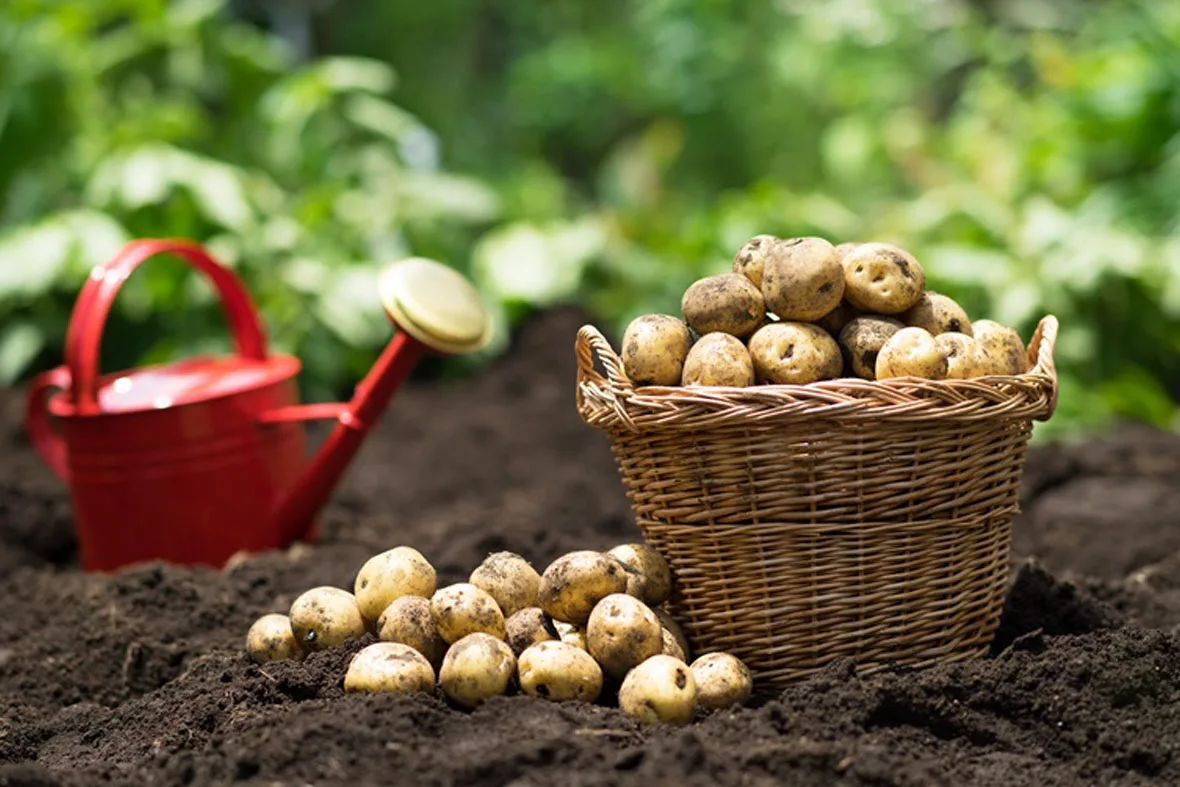Growing Potatoes at Home
Potatoes are a wonderful root crop to produce at home and are very easy to grow.
Planting certified Seed Potatoes
The term “seed potato” can be a little misleading. Although potatoes do set seed, they do not grow true to seed. To get the variety of potato you want, you need to grow them vegetatively, meaning you re-plant a part of the actual potato. These pieces of potato are referred to as seed potatoes.

Certified Seed Potatoes
Because potatoes are propagated vegetatively, any diseases from the prior year will be carried over.
That’s why it is so important to use disease-free seed potatoes. That means certified seed potatoes, rather than supermarket potatoes. Certified seed potatoes available at Burbank House & Garden are certified by a government authority to be disease-free.
Good seed potatoes will have at least 2-3 eyes per potato. If you have larger potatoes with many eyes on them you could cut them and grow a number of plants from one seed potato – just make sure that each chunk has not only 2-3 good eyes at a minimum but also plenty of flesh to help the potato grow.
Potatoes are planted about 15cm deep and about 30cm apart. Add some potato fertiliser. As potatoes are a root crop, potato fertiliser is high in Phosphorus which will encourage root development. To use a fertiliser high in Nitrogen will encourage lots of stem and foliage growth at the expense of the size and quantity of potatoes produced. Cover the potatoes after you plant them and wait.
Caring for Potato Plants in the Garden
You’ll start to see beautiful potato vines appear in a few days. The stems are pretty thick and the leaves are usually bright green. Let the vines grow until they are about 15cm tall and then you’ll need to do something called “hilling or mounding the potatoes”.
This can be done with soil, compost or straw – or a combination of these. Bury half of the plant leaving just the top few centimetres of leaves exposed.
The buried part of the vine will produce more roots, and most importantly, more potatoes. Meanwhile, the still-exposed leaves will continue to produce energy for the plant and will continue to grow even bigger. In another couple of weeks, you will hill or mound the growing plant up again.
Grow Potatoes in Containers
Potatoes are such an easy and versatile crop to grow they can be even grown without soil.
Potatoes can be grown in large pots, sacks, containers, barrels, old tyres even directly on concrete. When growing in containers it is important to ensure excellent drainage and, as in garden beds, use a potato fertiliser and continue to hill or mound the plants as they grow to produce even more potatoes. This will mean beginning in the bottom half of the pot or container and working your way to the top.
Harvest time
When the stems and leaves begin to die off, your potatoes are ready to harvest. Use a garden fork to dig under the root and bring the potatoes to the top. Begin well back to avoid spearing the potatoes. Freshly dug potatoes can be used straight away and are generally called new potatoes. Harvest as you need to and leave to the rest of the crop in the ground until you need them. Once the tops have completely died off, harvest the remaining crop and store in a dry, cool, dark location. Do not wash the potatoes that you wish to store as this acts as a protective coat. Potato sacks are great for storing your harvest for use when required.

Potatoes are Excellent in the Garden
Potatoes are perfect to add to your home-grown food forest. They will grow in a wide variety of soil, given that it is well-drained. They are easy to grow, have beautiful vines and flowers, and produce loads of delicious edible harvest for you. One small bag of Certified Seed Potatoes is transformed into many kilograms of potatoes right from your own garden.
